You’ve probably wondered which voice assistant works best with your home theater setup, especially when you’re juggling multiple remotes and struggling to find the right input. Whether you’re team Alexa, Google Assistant, or Siri, each platform offers distinct advantages for controlling your entertainment system. The real question isn’t just compatibility—it’s understanding which features you’ll actually use and how seamlessly they’ll integrate with your existing equipment.
Amazon Alexa Integration With Home Theater Systems
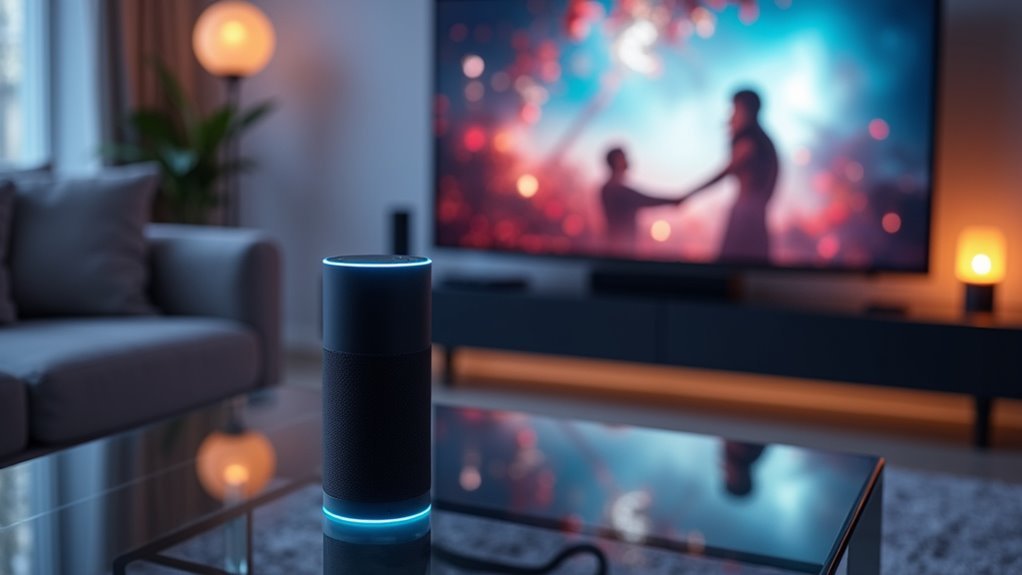
How often do you find yourself searching for the remote control when you want to adjust your home theater system?
Amazon Alexa eliminates this frustration by letting you control your home theater through simple voice commands. You can manage playback, adjust volume, and switch inputs without lifting a finger.
Voice control transforms your entertainment experience by eliminating the endless hunt for misplaced remotes and complicated button sequences.
To integrate Alexa with your system, connect your Alexa-enabled devices to compatible AV receivers or soundbars via HDMI-CEC or optical connections.
You’ll access powerful automation by creating custom routines in the Alexa app that dim lights and turn on your TV with one command.
Enable specific skills to access streaming services like Netflix and Hulu through voice control.
Alexa’s multi-room audio feature even lets you stream music throughout your home while enjoying your theater system.
Google Assistant Voice Commands for Entertainment Control
Chromecast integration enables high-resolution streaming when you command “stream this content to living room TV.”
You can even orchestrate complete scenes by saying “turn off the lights and start the movie,” controlling multiple devices simultaneously for the ultimate home theater experience.
Apple Siri and AirPlay 2 Home Theater Management
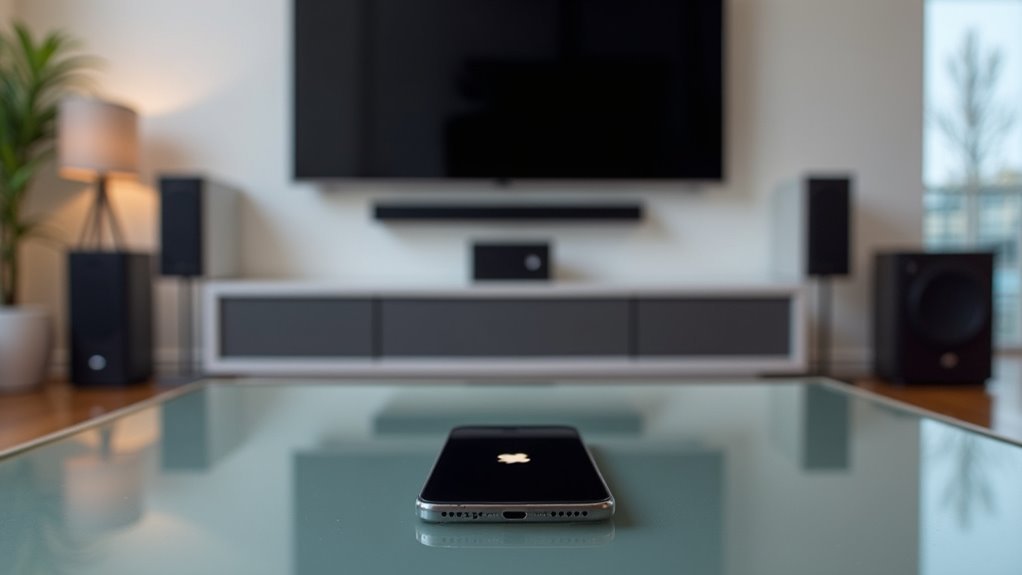
You can transform your home theater experience by leveraging Siri’s voice commands to control music playback across your entire entertainment system.
With AirPlay 2 integration, you’ll manage multiple speakers and devices simultaneously, creating seamless audio synchronization throughout different rooms.
Simply ask Siri to play your favorite Apple Music playlists, podcasts, or specific songs while your home theater system responds instantly to your voice commands.
Siri Music Playback
When you integrate Siri with your home theater system, you’ll transform how you control music playback throughout your entertainment space. You can use voice commands to seamlessly manage your audio system without touching remotes or phones.
Simply say “Hey Siri, play my favorite movie soundtrack” to instantly create the perfect atmosphere for movie nights.
AirPlay 2 enables you to stream high-quality audio to multiple speakers simultaneously, delivering synchronized playback across different rooms. You’ll easily adjust volume levels, skip tracks, or change playlists hands-free.
Siri also controls compatible smart devices through the Apple Home app, letting you integrate lighting and other automation features alongside your music playback for a complete entertainment experience.
AirPlay 2 Integration
AirPlay 2 integration transforms your home theater system into a wireless powerhouse that streams high-resolution audio and video directly from your Apple devices.
You’ll enjoy seamless streaming with low-latency technology that keeps audio and video perfectly synchronized, eliminating annoying lag during movies and shows.
Use Siri’s voice commands to control playback, adjust volume, and manage multiple AirPlay 2 speakers throughout your home effortlessly.
You can create sophisticated multi-room audio setups, streaming different content to various rooms or synchronizing playback across all connected devices simultaneously.
The Apple Home app centralizes your AirPlay 2 device management, letting you control your home theater system alongside other smart home features from one convenient interface.
This integration delivers professional-grade wireless entertainment that responds instantly to your voice.
Compatible Voice Assistant Devices and Setup Requirements
You’ll need to choose from three main voice assistant platforms—Amazon Alexa, Google Assistant, or Apple Siri—each offering distinct setup processes and compatibility requirements.
Your device selection impacts which home theater equipment you can control and how you’ll configure the initial connections through their respective mobile apps.
Before proceeding, you must verify that your existing audio and video components support your chosen voice assistant’s integration standards.
Voice Assistant Platform Options
Since modern home theater systems support multiple voice assistant platforms, you’ll want to choose the option that best fits your existing smart home ecosystem. Each platform offers distinct advantages and control solutions for managing your entertainment setup.
The primary voice assistant devices available include:
- Amazon Alexa – Download the Alexa app, connect to Wi-Fi, and link compatible music services with audio receivers for seamless voice-controlled playback.
- Google Assistant – Setup through Google Home app enables commands like “Hey Google, play my favorite playlist” on compatible devices.
- Apple Siri – Integrates with Apple Music and manages volume control through AirPlay 2 compatible speakers.
- Compatibility verification – Check that your home theater system supports voice control platforms, as some devices require specific models for full functionality.
Device Setup Requirements
Before you can start controlling your home theater with voice commands, you’ll need to verify that your equipment meets specific hardware and software requirements.
Your voice assistant devices must connect to your Wi-Fi network to communicate with your home theater components effectively. You’ll need Amazon Alexa, Google Assistant, or Apple Siri-compatible devices as your primary control hub.
Download the corresponding app for your chosen platform: Amazon Alexa app, Google Home app, or Apple Home app. These apps facilitate the linking process between your voice assistant and theater equipment.
To integrate voice control successfully, make sure your home theater receiver or speakers feature built-in voice capabilities or third-party compatibility.
Enable necessary skills and settings within your voice assistant’s app for seamless operation and peak performance.
Compatibility and Integration
When selecting voice assistant devices for your home theater setup, Amazon Alexa, Google Assistant, and Apple Siri stand as the three primary platforms that’ll transform how you control your entertainment system.
Before diving into integration, you’ll need to verify compatibility between your chosen voice assistant and existing home theater components.
Here’s what you must establish for seamless operation:
- Download the corresponding app – Amazon Alexa app, Google Home app, or Apple Home app
- Connect your voice assistant to home Wi-Fi network for communication
- Install a gateway model like WGW-SLX to bridge your home audio app with voice platforms
- Enable necessary skills or features in your assistant’s app for enhanced control capabilities
Proper compatibility verification guarantees ideal integration performance across all connected devices.
Connecting Voice Controls to Audio Receivers and Speakers
While modern audio receivers make voice integration straightforward, you’ll need to verify compatibility with your chosen voice assistant platform before diving into the setup process.
Once confirmed, download the corresponding app—Amazon Alexa, Google Home, or Apple HomeKit—and follow the linking procedures to connect your receiver.
Download your voice assistant’s dedicated app and complete the linking process to establish communication between your receiver and smart home ecosystem.
After successful pairing, you can issue voice commands to adjust volume, switch inputs, and control playback without touching a remote.
For multi-room setups, integrate compatible wireless speakers to extend home control throughout different areas.
Remember that specific command syntax matters—you might need to say “ask” or “tell” before your instruction, depending on your voice assistant, to guarantee proper communication with your audio system.
Multi-Room Audio Control Through Voice Commands
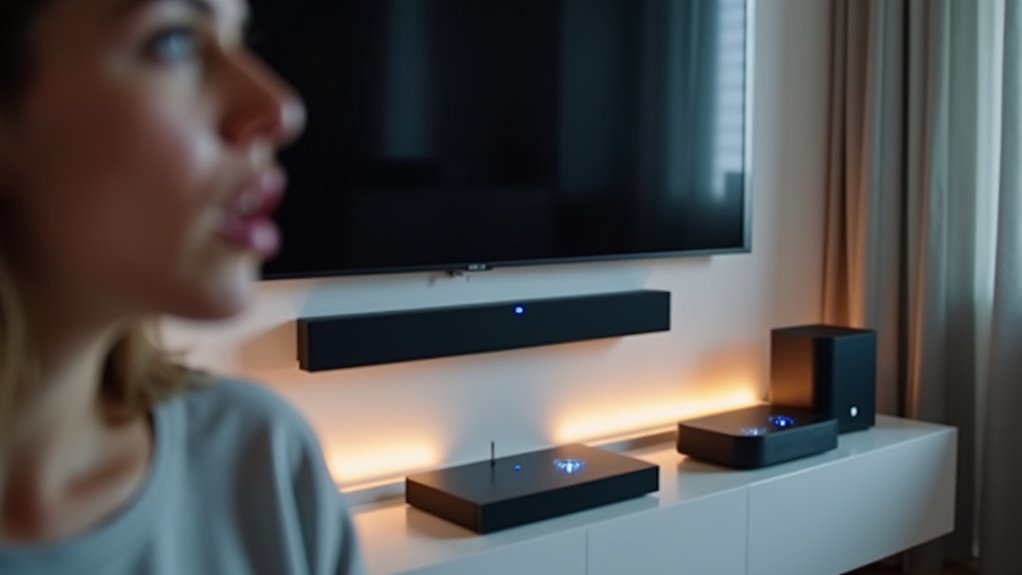
Taking voice control beyond a single receiver opens up exciting possibilities for managing audio throughout your entire home.
Multi-room audio control transforms how you experience sound by letting voice commands orchestrate playback across different zones simultaneously.
You can direct specific audio to designated rooms with simple requests like “Alexa, play jazz in the kitchen” or adjust individual volume levels without touching physical controls.
Here’s what multi-room audio control enables:
- Zone-specific playback – Target music to particular rooms or speakers
- Synchronized audio – Play the same content across multiple spaces
- Individual volume control – Adjust levels in each room independently
- Automated routines – Create custom commands for multiple rooms at once
Smart home platforms like HTD Home Audio enhance these capabilities by seamlessly linking voice commands to your existing zones.
Smart TV and Streaming Device Voice Integration
Although multi-room control provides impressive whole-home capabilities, your smart TV and streaming devices represent the most direct pathway to voice-controlled entertainment. You’ll find built-in assistants like Alexa, Google Assistant, and Siri seamlessly integrated into modern smart TVs from Samsung and LG, creating an intuitive control hub.
| Voice Feature | Your Command | Instant Result |
|---|---|---|
| Content Search | “Find action movies” | Effortless discovery |
| Playback Control | “Pause the show” | Immediate response |
| Smart Home Works | “Turn off all lights” | Perfect ambiance |
Voice-enabled remotes for Roku and Apple TV let you search hands-free, while Chromecast integration streams content directly from your mobile device using voice commands. These voice commands control everything from volume adjustment to input switching, transforming your entertainment experience into something truly magical.
Home Theater Lighting Control via Voice Assistants
You can transform your home theater’s atmosphere instantly with voice-activated ambient lighting that responds to simple commands like “dim the lights to 20%” or “set theater mode.”
Smart dimming commands let you adjust brightness levels precisely without fumbling for switches in the dark, creating the perfect viewing environment for any content.
Your voice assistant becomes a lighting director, seamlessly shifting between bright room lighting and cinematic ambiance with just a few spoken words.
Voice-Activated Ambient Lighting
Convenience transforms your home theater experience when you integrate voice-activated ambient lighting into your entertainment setup. Smart bulbs like Philips Hue or LIFX seamlessly respond to voice commands through Alexa or Google Assistant, letting you control brightness and color settings effortlessly.
Here are four key benefits of voice-activated ambient lighting:
- Custom scenes – Create specific lighting moods like “Movie Time” that activate with simple voice commands.
- Automatic scheduling – Program lights to adjust at predetermined times without manual intervention.
- Instant adjustments – Use commands like “Hey Google, dim the lights” for immediate atmosphere changes.
- Smart integration – Connect with other home theater devices through automation platforms for a cohesive experience.
This technology eliminates fumbling for light switches during movies, maintaining your viewing immersion.
Smart Dimming Commands
Smart dimming commands revolutionize how you control your home theater’s lighting atmosphere through simple voice instructions. You can create precise voice commands like “Alexa, dim the living room lights to 50%” for exact lighting control during movie nights. Integration with smart lighting systems such as Philips Hue or Lutron enables seamless voice-activated dimming without manual adjustments.
| Voice Command | Action |
|---|---|
| “Hey Google, set movie mode” | Dims lights and adjusts theater settings |
| “Alexa, dim lights to 25%” | Sets specific brightness level |
| “Turn off ambient lighting” | Complete darkness for viewing |
| “Set romantic lighting” | Custom mood scene activation |
You can link voice commands to specific scenes and group lighting controls with audio-video systems, managing your entire home theater environment through single voice instructions for ultimate convenience.
Creating Custom Voice Commands and Routines
Why settle for basic voice commands when you can craft personalized controls that transform your entire entertainment space with a single phrase?
Creating custom voice commands and routines lets you orchestrate multiple devices simultaneously through simple verbal triggers.
Here’s how to maximize your setup:
- Design activity-based routines – Say “movie night” to dim lights, power on your projector, and adjust audio levels automatically.
- Create personalized streaming commands – Use “play my action playlist” to launch specific services and set preferred volume settings.
- Build extensive scene controls – Program “home theater mode” to coordinate devices across different platforms seamlessly.
- Establish daily routines – Set “good night” commands to power down all entertainment systems and adjust environmental controls.
These custom voice commands eliminate multiple steps, creating effortless entertainment experiences.
Privacy Settings and Voice Control Security Options
You’ll want to configure your voice control system’s privacy settings to protect your personal data and maintain security while enjoying hands-free entertainment.
Most devices offer physical mute buttons and software controls that let you disable voice activation when you’re not actively using the system.
You can also manage how your voice data is stored, processed, and deleted through your device’s companion app settings.
Voice Data Protection
When you’re using voice controls for your home theater system, protecting your personal data becomes a critical consideration. Voice commands contain sensitive information that needs proper safeguarding.
Fortunately, modern voice assistants offer robust privacy features to help secure your data.
Here’s how you can protect your voice data:
- Enable local processing – Many devices process voice commands directly on the hardware, reducing cloud transmission risks.
- Use physical mute buttons – Smart speakers like Google Nest Mini include hardware switches to disable listening capabilities.
- Configure app settings – Disable microphone access and manage recording preferences through your voice assistant’s mobile app.
- Encrypt all transmissions – Leading brands automatically encrypt voice data during processing and storage phases.
You’ll also find options to delete voice history and control data usage for recognition improvements.
Microphone Control Features
How can you maintain complete control over your home theater’s microphone while enjoying seamless voice functionality? Physical microphone control switches give you instant privacy protection. Systems like Sonos include dedicated power switches that entirely disable microphones when you’re not using voice commands.
Your privacy settings offer thorough data management through companion apps. You’ll find options to control how your voice data gets used and stored, with many systems processing requests locally rather than sending audio to the cloud.
| Feature | Benefit |
|---|---|
| Physical mic switch | Instant privacy control |
| Voice profiles | Authorized user access only |
| Local processing | No cloud data transmission |
Advanced microphone control includes unique voice profiles, ensuring only authorized users can command your system while protecting against unauthorized access.
Troubleshooting Common Voice Control Issues
While voice controls can transform your home theater experience, technical hiccups often disrupt the seamless operation you’re expecting. When your voice assistant fails to respond properly, several quick fixes can restore functionality.
Voice control technology promises convenience, but when systems malfunction, simple troubleshooting steps can quickly restore your smart home theater setup.
- Check Wi-Fi connectivity – Confirm your voice assistant maintains a stable connection to your home network, as connectivity issues prevent proper command recognition and execution.
- Update firmware regularly – Keep your voice control devices and home theater components current to maintain compatibility and peak performance.
- Use specific phrases – Speak clearly with precise voice commands rather than vague instructions, as voice assistants respond better to detailed requests.
- Enable proper integrations – Verify that necessary skills and app integrations are activated to guarantee full functionality between your voice assistant and home theater system.
Advanced Automation With Scheduled Voice Triggers
Beyond basic voice commands lies the power of scheduled automation, where your home theater system anticipates your entertainment needs without prompting. You can program voice control systems to activate automatically at specific times, eliminating manual intervention entirely.
Create thorough routines that combine multiple actions—dimming lights, lowering shades, and powering on your projector—with single scheduled commands.
Advanced automation integrates seamlessly with other smart home devices, optimizing your entire viewing environment before movies begin. Using platforms like Alexa or Google Assistant, you’ll set specific schedules that transform your space without touching physical remotes.
This sophisticated approach guarantees your entertainment system responds intelligently to your lifestyle patterns, delivering cinema-ready experiences precisely when you want them, enhancing convenience and creating truly personalized home theater automation.
Professional Installation Vs DIY Voice Setup
Setting up these sophisticated automation systems requires an important decision: should you handle the installation yourself or hire professionals?
Both professional installation and DIY voice setup offer distinct advantages depending on your technical expertise and budget.
Key considerations for choosing your approach:
- Cost vs. Quality – DIY voice setup saves money but professional installation guarantees superior configuration and seamless integration with existing components.
- Technical Support – Professionals provide ongoing maintenance and troubleshooting, while DIY requires self-reliance for future issues.
- Customization Level – Professional services offer tailored solutions for specific spatial configurations and user preferences.
- Advanced Features – Professional installation typically delivers refined multi-room audio control and sophisticated automation that DIY setups might lack.
Your choice depends on balancing cost-effectiveness with long-term reliability and feature sophistication.
Future Trends in Voice-Controlled Home Entertainment
As voice-controlled entertainment technology rapidly evolves, you’ll soon experience unprecedented levels of sophistication and personalization in your home theater setup.
AI-driven recognition will make your voice commands more accurate and responsive, creating seamless interactions with all your devices. You’ll control televisions, streaming platforms, and sound systems through single commands across multiple platforms.
Future systems will learn your preferences, automatically recommending content and adjusting settings based on your viewing history.
Enhanced natural language processing will let you make conversational requests like finding specific movie scenes or mood-based playlists.
Your smart home integration will become more thorough, coordinating actions like dimming lights and adjusting temperature when you start watching movies, creating the perfect entertainment environment effortlessly.
Frequently Asked Questions
What Does the Voice Control?
You’ll control TV power, volume, channels, and inputs through voice commands. You can manage streaming services, adjust sound modes, change picture settings, and execute complex multi-device scenes like “Movie Night” setups.
What Can Sonos Voice Assistant Do?
You can control music playback across streaming services, adjust volume, group rooms, set timers, check weather, and manage TV settings. It processes commands locally, ensuring your privacy while providing hands-free control.
How Do I Get My TV to Play Sound Through My Home Theater System?
Connect your TV’s audio output to your home theater receiver using HDMI ARC, optical, or RCA cables. Set your receiver to the correct input, enable ARC if applicable, and select your home theater system in your TV’s audio settings.
Can We Connect Alexa to Home Theater?
You can connect Alexa to your home theater system using an Alexa-compatible receiver or smart device. Once connected, you’ll control playbook, volume, and settings with voice commands like “Alexa, turn on.”

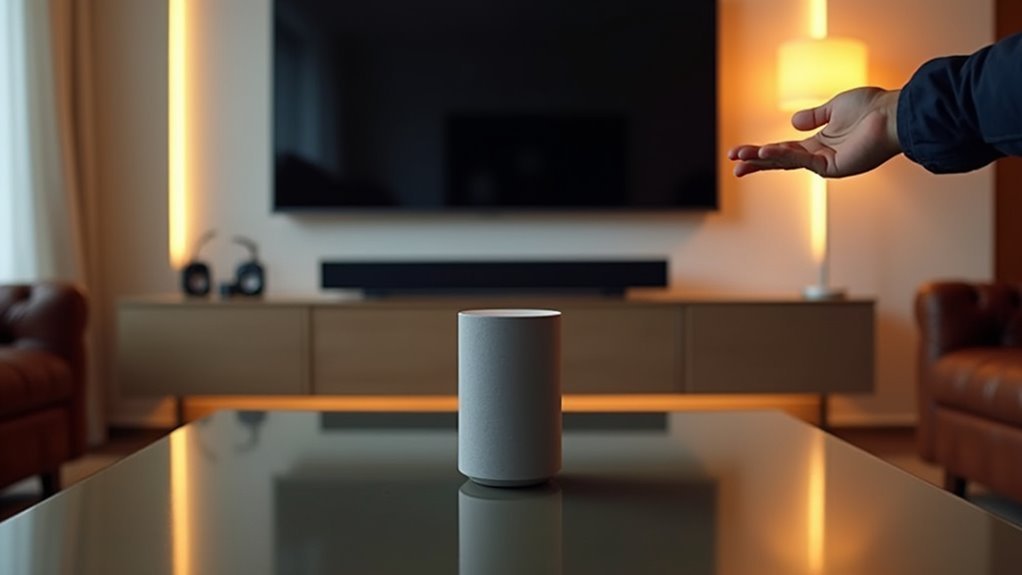


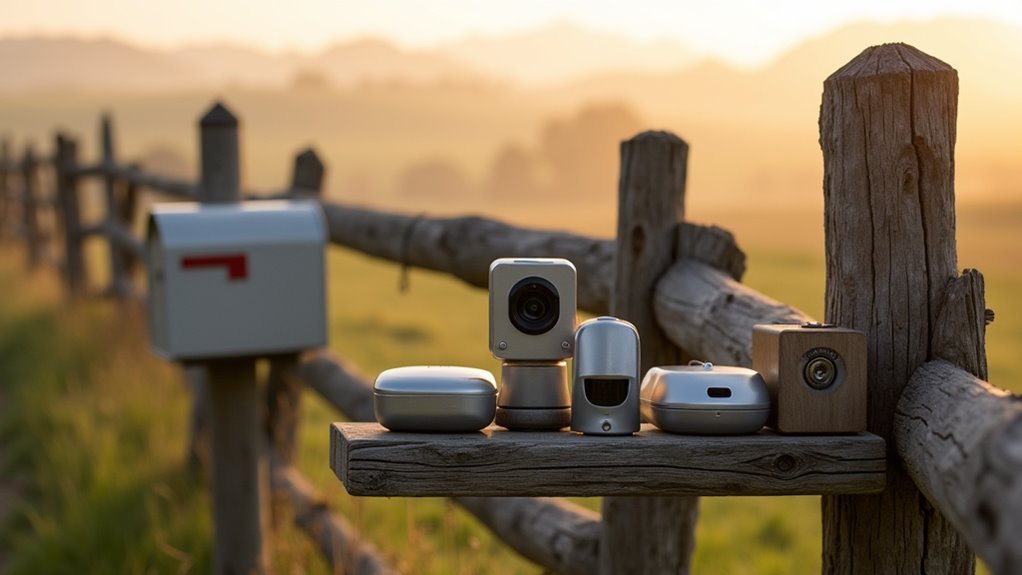
Leave a Reply